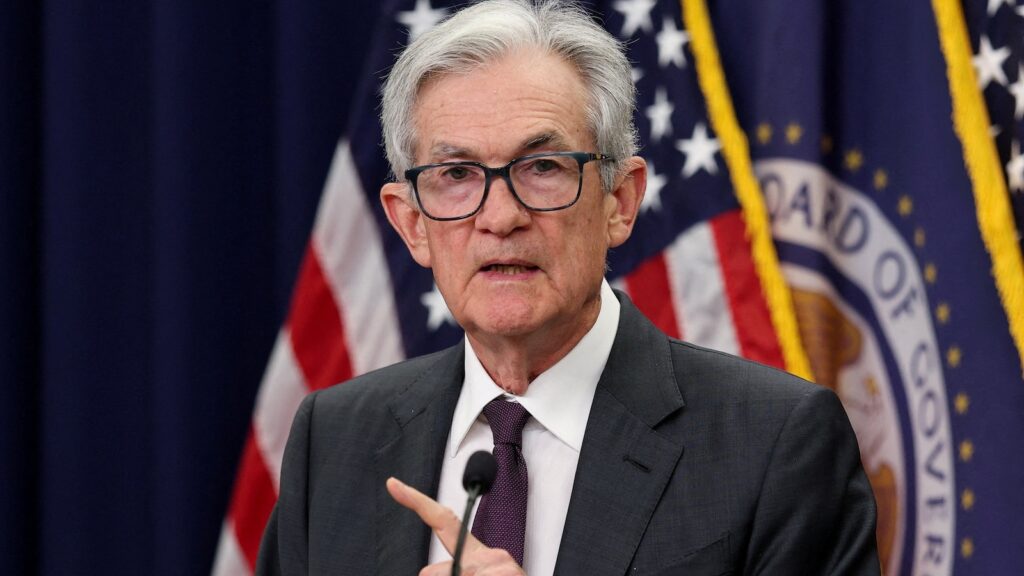Federal Reserve Chair Jerome Powell on Friday said the central bank faces a “challenging situation” as a hiring slowdown coincides with tariff-driven price increases, putting pressure on both sides of the Fed’s dual mission to maximize employment and control inflation.
Speaking at an annual gathering in Jackson Hole, Wyoming, Powell said “the effects of tariffs on consumer prices are now clearly visible.” He added that the Fed expects those price increases to “accumulate over the coming months.”
Still, Powell said, the “balance of risks appears to shifting” in light of a hiring slowdown made clear in a weak jobs report earlier this year that included sharp downward revisions of job gains over recent months.
Powell said the Fed would “proceed carefully” but he hinted at the possibility of a change to interest rates, saying “the shifting balance of risks may warrant adjusting our policy stance.”
For months, President Donald Trump has urged the Fed to lower interest rates in an effort to boost economic performance and reduce interest payments on government debt. So far, the Fed has refused, opting to hold interest rates steady as policymakers observe the effects of tariffs.
Trump ratcheted up his pressure campaign this week, calling on Fed Governor Lisa Cook to resign after a Trump administration official alleged that she had committed mortgage fraud. Cook rebuked the push for her to quit, saying she has “no intention of being bullied to step down from my position because of some questions raised in a tweet.”
The political clash has coincided with a fraught moment for the central bank.
Hiring slowed sharply in recent months, threatening to undermine a part of the Fed’s mission devoted to maximizing employment. At the same time, a measure of underlying inflation has picked up, putting at risk the central bank’s effort to control price increases.
Policymakers face a bind. If the Fed raises interest rates as a means of protecting against tariff-induced inflation, it risks tipping the economy into a downturn. On the other hand, if the Fed lowers rates to stimulate the economy in the face of a potential slowdown, it threatens to boost spending and worsen inflation.
Five meetings and eight months have elapsed since the Fed last adjusted interest rates. The federal funds rate stands between 4.25% and 4.5%, preserving much of a sharp increase imposed in response to a pandemic-era bout of inflation.
“Higher tariffs have begun to show through more clearly to prices of some goods, but their overall effects on economic activity and inflation remain to be seen,” Powell said at a press conference in Washington, D.C., last month. “We believe that the current stance of monetary policy leaves us well positioned to respond in a timely way to potential economic developments.”
Those comments came days before a jobs report on Aug. 1 that included sharp downward revisions of job gains over recent months. The speech on Friday marked the first public remarks from Powell since the weak jobs report, offering him a chance to inform onlookers about whether he remains primarily concerned about inflation or employment.
President Donald Trump and Federal Reserve Chair Jerome Powell talk to reporters while touring the Federal Reserve’s $2.5 billion headquarters renovation project, July 24, 2025 in Washington.
Chip Somodevilla/Getty Images
Futures markets are expecting a rate cut when the Fed holds its next meeting in September. Investors peg the chances of a quarter-point interest rate cut at nearly 75%, according to the CME FedWatch Tool, a measure of market sentiment.
In his speech at Jackson Hole, Powell did not appear to address pressure from the Trump administration.
In recent weeks, Trump has slammed Powell over cost overruns tied to the central bank’s $2.5 billion building renovation project.
The Fed attributes spending overruns to unforeseen cost increases, saying that its building renovation will ultimately “reduce costs over time by allowing the Board to consolidate most of its operations,” according to the central bank’s website.
Federal law allows the president to remove the Fed chair for “cause,” though no president has ever done so. Powell’s term as chair is set to expire in May 2026.
At the press conference last month, Powell advocated for the independence of the Federal Reserve.
Political independence, Powell said, gives central bankers the “ability to make these very challenging decisions in ways that are focused on the data, the evolving outlook, the balance of risks – and not on political factors.”


